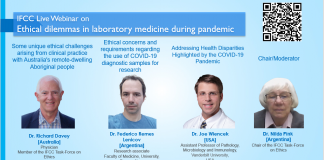For the first time in 15 years, globally recognized criteria for sepsis and septic shock have been updated. The new definitions were presented at the Society of Critical Care Medicine’s 45th Critical Care Congress and published in the Journal of the American Medical Association (JAMA).
Federal regulators and the medical community alike have ramped up their focus on sepsis, a deadly condition that injures organs in response to an infection and can lead to septic shock. It affects at least 3 million patients annually and accounts for more than 5% of all hospital costs. As CLN Stat reported last fall, the Centers for Medicare and Medicaid Services on Sept. 17, 2015, issued a prescriptive list of new quality reporting measures on how to respond to and treat adult patients with either severe sepsis or septic shock.
Now there are new recommended definitions for these conditions. In 2014, an international task force of medical specialists from the European Society of Intensive Care Medicine and the Society of Critical Care Medicine convened to reassess the clinical criteria for sepsis. A number of symptoms may indicate infection, making sepsis difficult to diagnose. “Because no gold standard diagnostic test exists, the task force sought definitions and supporting clinical criteria that were clear and fulfilled multiple domains of usefulness and validity,” the task force explained in the JAMA article.
The task force also had to consider the medical advances that had taken place since the last time these definitions were revised in 2001 with respect to pathobiology, epidemiology, and management of this condition.
Derek C. Angus, MD, MPH, a task force member who chairs the critical care medicine department at the University of Pittsburgh Schools of the Health Sciences, explained in a video statement from JAMA why the definition of “sepsis” was ready for an update.
“We noticed that the terminology of sepsis had become incredibly confusing and that a number of terms had become obsolete or outdated. For example, terms such as ‘septicemia’ don’t really help in that many patients can be septic without having positive blood cultures,” Angus said. In addition, clinical criteria for systemic inflammatory response syndrome (SIRS) haven’t been particularly helpful in diagnosing patients for sepsis.
“We felt it was helpful to have an overarching conceptual definition that better explained what sepsis is,” he said.
The revised definition for sepsis specifies that it is a life-threatening organ dysfunction caused by a dysregulated host response to infection. “Organ dysfunction” is characterized by an increase of 2 points or more in the Sequential [Sepsis-related] Organ Failure Assessment, or SOFA, which correlates to an in-house mortality rate of more than 10%.
Septic shock should be classified as a subset of sepsis “in which particularly profound circulatory, cellular, and metabolic abnormalities are associated with a greater risk of mortality than with sepsis alone,” the task force indicated.
The expectation is this definition “results in greater consistency for epidemiologic studies, clinical trials and—perhaps most important—better recognition and more timely management of patients with, or at risk of developing, sepsis,” said Angus in a statement. The panel characterized septic shock as occurring in patients with sepsis who have two other findings: persistent hypotension that requires vasopressors to maintain a mean arterial pressure ≥65 mm Hg; and serum lactate level >2 mmol/L (18 mg/dL) despite adequate volume resuscitation. The in-hospital mortality rate of patients with septic shock exceeds 40%, according to the task force.
To rapidly identify and treat adult patients with suspected infection regardless of clinical setting, the revised definition included the “quick Sepsis-related Organ Failure Assessment,” or qSOFA. This new bedside clinical score uses three symptoms: respiratory rate ≥22/min, altered mental activity, or systolic blood pressure ≤100 mm Hg. Patients would need to present with at least two of these symptoms to receive treatment outside of an intensive care unit (ICU).
In a comparative analysis of clinical criteria designed to identify patients at risk for sepsis, researchers determined that when patients were identified outside the ICU, qSOFA’s ability to predict in-hospital mortality was superior to other methods such as SOFA and SIRS, “supporting its use as a prompt to consider possible sepsis,” according to the findings, which were published in JAMA.
This new criteria represents the best working definitions of today. However, a “gold standard” for measuring sepsis has yet to be developed, Angus emphasized in the video statement. For this reason, he expects discussions on sepsis measures to continue.
“We do not see this as the end. We welcome efforts both near and in the long term to extensively validate some of these measures such as qSOFA. As we have further advances in our understanding of the pathophysiology and pathobiology of sepsis, we welcome the development and incorporation of new biomarkers for sepsis.”
Source: AACC











